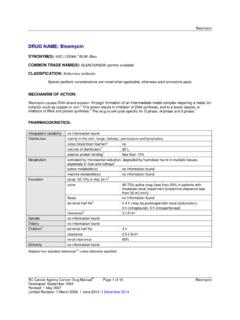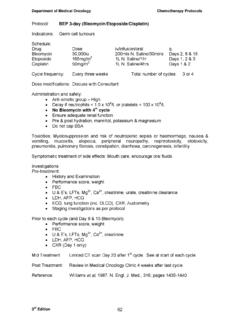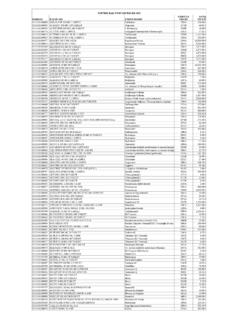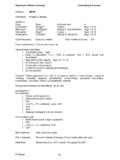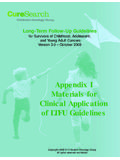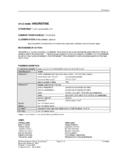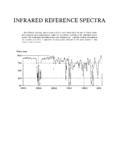Transcription of Preoperative Assessment for Pulmonary Surgery
1 Preoperative Assessment for Pulmonary SurgeryPeter Slinger MD, FRCPC55 Male, Carcinoma Right Middle and Lower lobes, PneumonectomyPulmonary Resection Morbidity and MortalityAll Cases(LCSG 89)Mortality4%Respiratory Complications21%Cardiac Complications15%1 1 Diffusing Capacity Predicts Operative Mortality but not Long-term SurvivalWang J, JTCVSurg117: 581, 1999 National Emphysema Treatment TrialNEJM 348: 2059-78, 2003 Increased Risk of Death: Homogeneous Emphysema FEV1 < 20% DCO < 20%Lance Armstrong VO2 max = 85ml/kg/min J ApplPhysiol98: 2191, 2005 The 3-Legged Stool of Pre-Thoracotomy Respiratory Assessment :Lung 1(ppo< 40%)DLCO(ppo< 40%)VO2 max(15 ml/kg/min)MVV, FVCRV/TLCPaO2 < 65 PaCO2 > 45 Stair climb >2 min. walkExercise SpO2 Post-thoracotomy Anesthetic Management:Predicted Postop. FEV1 (ppoFEV1%)> 40%40-30%30-20%Extubatein OR if patient AWaC Extubateif other factors favorable:Consider Extub. if all favorableplus TEA(alert, warm and comfortable)Exercise Tol.
2 , DLCO,V/Q scan Assoc. diseasesOther patients: staged wean of ventilationPost-thoracotomy Cardiac Complicationsvon Knorring, et al. Ann ThoracSurg1992, 53:6420510152025012345 IschemiaArrhythmia# Risk Assessment for ThoracotomyCase Specific AngioNon-Invasive TestingPoor FunctionalCapacityORAdequate FunctionalCapacityIntermediate Clinical Predictors-Mild Stable Angina, Prev. MI-Diabetes-Compensted /prev. CHFOKHighRisk(ACC/AHA Guidelines, Anesth Analg 2007, 104:15-26) Pulmonary Resection Morbidity and MortalityAll Cases(LCSG 89)>80 Years(Osaki 94)Mortality4%3%Respiratory Complications21%44%Cardiac Complications15%44%Stair Climbing Predicts Post-lobectomy Complications in the Elderlyn= 109, Age >70, mortal. 3%, morbid. 27% ppoFEV1 % p= Cardiac co-morbidity p= Stair climbing p= .002 BrunelliA, et al. Ann ThoracSurg77: 226-70, 2004 Pre-thoracotomy Cardiac Risk Assessment ? Risk Risk < 4 METSORE xcellent >> 4 METSE lderlyHigh RiskLow RiskWhich Drug is NOTE ffective in Preventing Post-thoracotomy Atrial Drug is NOTE ffective in Preventing Post-thoracotomy Atrial Ventilation-Perfusion MatchingAirCOPD Ventilation-Perfusion MatchingAirHigh FiO2 Pre-anesthetic Considerations for Lung Cancer (the 4 Ms ) Mass Effects Metabolic Effects: Na+, Ca++,Eaton-Lambert Metastases Medications: Bleomycin, Adriamycin, Cis-PlatinumHelping Surgical Patients Quit SmokingWarner DO, Anesth Analg 2005; 101: 481-7 Abstinence @ 1yr: After ACB: 55% Angioplasty : 25% Angiography: 14%Surgical Benefits: Decrease ST changes intraop.
3 : 2 days Decrease wound complic s: >4wk. Decrease Resp. Complications : Cardiac: >8 wk. Thoracic: > 4 weeksPreoperative Phyisotherapy Proven decrease in Pulmonary complications in COPD Particularly in patients with excessive secretions No proven superior modalityWarner DO, Anesthesiology 2000, 92: 1467 Reduction of Respiratory Complications in Lung Resection by Thoracic Epidural010203040506070 FEV1>60%FEV1>60+TEA3-D Column 3 FEV1<60%FEV1<60+TEA** p < .05 vs. withoutTEA%RespiratoryComplications*Norm al PFTsCOPDL icker M, et al. Ann ThoracSurg2006; 81: 1830-8 Will this patient tolerate a pneumonectomy?Will this patient tolerate a pneumonectomy? Age 55 FEV1 50% DLCO 45% Exercise tol. 3 flights V/Q R:L40: 60 pH PaCO2 48 PaO2 68 Surgical Options: Sleeve Resection Bi-lobectomy Segment/Wedge Resection VATS Emphysema this patient will tolerate a Pulmonary resection?Initial Pre-Anesthetic Assessment for Pulmonary Resection All patients:Exercise tolerance, ppoFEV1%, D/C smoking, Regional analg.
4 , ? Imaging ppoFEV1 < 40 %:DLCO, Exercise test, V/Q scan Cancer patients:the 4-Ms , s. electrolytes COPD:ABG, chest physio., bronchodilatorsFinal Pre-Anesthetic Assessment for Pulmonary Resection Review Initial Assessment and Test Results Examine the Chest X-ray and CT scan Assess the Risk of Hypoxemia During One-Lung VentilationFinal Pre-Anesthetic Assessment for Pulmonary Resection Review Initial Assessment and Test Results Examine the Chest X-ray and CT scan Assess the Risk of Hypoxemia During One-Lung VentilationWhich Patient more likely Desaturate during OLV?60 M, Lung , FEV1= 98%55 F, EmphysemaFEV1= 28%R Thoracotomy, Upper VATS LVRP rediction of DesaturationDuring One-lung Ventilation Right vs. Left Thoracotomy Lung elastic recoil low PaO2 during 2-lung ventilation V/Q ratio to surgical side60 M, Lung , FEV1= 98% Preoperative Assessment for Thoracic Surgery References: BecklesMA, et al. Physiologic Evaluation of patients with lung cancer for Surgery .
5 Chest 123: 105s-114s, 2003 Slinger P, Johnston Assessment : an anesthesiologist's 2005 Feb;15(1):11-25 Preoperative Assessment for Pulmonary SurgeryPeter Slinger MD, FRCPC
